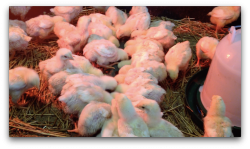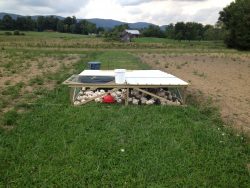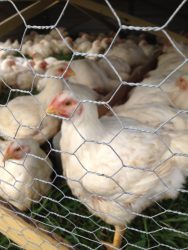Start Small: Sage Advice for Agriculture
Start small. This is sage advice for all sorts of endeavors, but I feel it is especially and broadly true with agriculture.
It is for this reason that I wanted to pilot a pastured poultry enterprise at Harbin Hill Farms as well as to test its economic viability. For all of the unseen challenges, seemingly fated mishaps, and uncertainties that go with agricultural enterprises, it seemed best to have a trial run. For, while I had been responsible for the daily care of pastured poultry before and participated in processing days multiple times, I had never born the weight of the back-office work, the planning, the marketing, and the management.

Our goal was to raise our birds thoughtfully and healthfully, so we chose to do without any vaccines or antibiotics, to feed them only non-GMO feed, and to supplement their diet with kelp and fresh pasture. After two weeks in the brooder, we put them out on pasture, moving the pen daily at first due to the birds’ size, then twice per day for the final four weeks. We decided to follow Joel Salatin’s tried-and-true model for our floor-less pen construction. Daily chores were mostly uneventful and simple. However, I learned that having a larger supply of water on hand is crucial in these hot climates. Even in the cooler air of these Appalachian mountains, our chickens drank up to 10 gallons per day.

Our losses were within tolerance, at roughly 5%.
In fact, I ordered 98 chickens, which was more than I needed. I prepared to lose up to 8% in addition to any we might lose to error and have around 85 chickens reach full maturity. We were pleasantly surprised to have 93 chickens to process. As expected, most of our losses occurred during the first week, but we also lost one chicken the first night on pasture and another the Friday before processing. Our feed conversion ratio (FCR) was 2.74:1. For our purposes, this ratio shows the pounds of food consumed to pounds gained on the animal after processing. Industry standard FCR is around 2.5 and many pastured poultry growers average 3:1 or 3.5:1, so I am pleased with our results.

Things were going smoothly. Then, processing day came. I carefully prepared knowing that something would inevitably go wrong (it did). We worked from 7 AM to 12 AM! We laughed. We wanted to cry. We learned more than we had hoped. My mentor, Richard, my coworkers, Joe and Josh, my returning coworker, Nico, and I made it happen. It would not have been possible without their help nor would it have been possible without my friend who lent us his processing equipment and advice. My goal was to pilot the enterprise for Harbin Hill and to discover how economically viable such an enterprise would be for a beginning farmer. In that regard, the project was a success!

My predictions for this pilot were that we would break even or, at best, make some pocket change. If one calculated only the equipment, poultry, feed, and daily chores, then we well may have though some of our expenses were non-recurring investments. However, as in all farming, the greatest expense is labor. Despite our expenses, I ask myself, “What does satisfaction feel like?” If satisfaction is not holding a pasture-raised, 5 lb. chicken in one’s hands from one’s farm, then I don’t know what is (never mind holding about one hundred of them). Actually, I think I can do one better: having a happy customer hungrily report that your chicken tastes great and ordering yet another.
So, how about it, reader? Are you ready to buy some of our chickens?
Jacob Nessamar – 2018 FARM Intern, Harbin Hill Farms